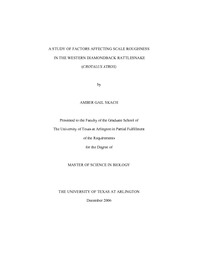
ATTENTION: The works hosted here are being migrated to a new repository that will consolidate resources, improve discoverability, and better show UTA's research impact on the global community. We will update authors as the migration progresses. Please see MavMatrix for more information.
Show simple item record
| dc.contributor.author | Skach, Amber Gail | en_US |
| dc.date.accessioned | 2007-08-23T01:55:57Z | |
| dc.date.available | 2007-08-23T01:55:57Z | |
| dc.date.issued | 2007-08-23T01:55:57Z | |
| dc.date.submitted | December 2006 | en_US |
| dc.identifier.other | DISS-1546 | en_US |
| dc.identifier.uri | http://hdl.handle.net/10106/42 | |
| dc.description.abstract | Reptilian scales are very complex with patterns across their surface like a human fingerprint. These patterns are species specific, but there has been no way to quantify differences. A new technique using the confocal microscope allows measurement of the roughness of a surface. The roughness of the scales of Crotalus atrox were measured and compared with factors such as sex, age, clade, and various environmental variables to determine if this technique may be useful in determining species. The results found that the roughness of a scale decreased as the snake aged, and was significantly different between the two clades; the Eastern clade being much rougher. When these factors were controlled in the environmental factor analysis, it was found that higher temperature seasonality and higher maximum temperature in the warmest month caused an increase in scale roughness. | en_US |
| dc.description.sponsorship | Arnott, Howard | en_US |
| dc.language.iso | EN | en_US |
| dc.publisher | Biology | en_US |
| dc.title | A Study Of Factors Affecting Scale Roughness In The Western Diamondback Rattlesnake (Crotalus atrox) | en_US |
| dc.type | M.S. | en_US |
| dc.contributor.committeeChair | Arnott, Howard | en_US |
| dc.degree.department | Biology | en_US |
| dc.degree.discipline | Biology | en_US |
| dc.degree.grantor | University of Texas at Arlington | en_US |
| dc.degree.level | masters | en_US |
| dc.degree.name | M.S. | en_US |
| dc.identifier.externalLink | https://www.uta.edu/ra/real/editprofile.php?onlyview=1&pid=64 | |
| dc.identifier.externalLinkDescription | Link to Research Profiles | |
Files in this item
- Name:
- umi-uta-1546.pdf
- Size:
- 10.50Mb
- Format:
- PDF
This item appears in the following Collection(s)
Show simple item record


